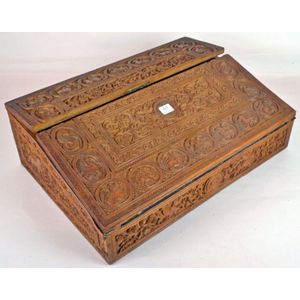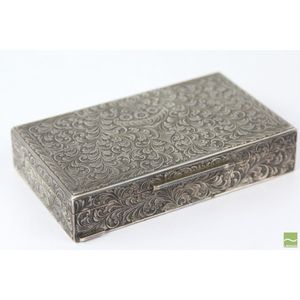Regency Writing Slope with Brass Inlay and Hidden Drawer
You must be a subscriber, and be logged in to view price and dealer details.
Subscribe Now to view actual auction price for this item
When you subscribe, you have the option of setting the currency in which to display prices to $Au, $US, $NZ or Stg.
- Regency Period - The Regency period in English furniture design refers to the period when King George III, was declared unfit to rule in 1811, and his son ruled as proxy as Prince Regent, until 1820, and then, after the death of his father as George IV until his death in 1830. The Regency period was preceded by the Georgian period (George I, George II, and George III: 1714 - 1811), and was followed by the William IV period, which only lasted until 1837 when William IV died as was succeeded by Queen Victoria.
- Baize - Baize is a type of fabric that is made from wool or a wool blend. It is a dense, closely-woven fabric that is smooth to the touch and has a matte finish. Baize is often used for covering surfaces, such as table tops or the playing surface of card, pool and billiard tables, and for lining drawers and boxes, because it is durable and resistant to wear. This fabric is often associated with gambling and is often used on casino gaming tables and other gaming equipment.
- Mahogany - Mahogany is a dense, close grained red-coloured timber from the West Indies and Central America. It was first imported into Europe in the the early 18th century and its use continued through the 19th century. It was popular for furniture making because of its strength, the wide boards available, the distinctive grain on some boards, termed flame mahogany and the rich warm colour of the timber when it was polished.. The "flame" was produced where a limb grew out from the trunk of the tree, and this timber was usually sliced into veneers for feature panels on doors, backs and cornices.
Some terms used to describe mahogany relate to the country from which it originally came, such as "Cuban" mahogany, "Honduras" mahogany etc. However unless the wood has been tested the names assigned are more a selling feature, rather than a true indication of the timber's origin.
This item has been included into following indexes:
Visually similar items

An Anglo Indian carved sandalwood writing slope late 19th century decorated with fine carved leaves and flowers, exotic animals with tooled velvet writing surface the interior with inkwell, sand pot, various writing compartments, height 12 cm, width 37 cm,

A stunning Anton Seuffert jewellery box, inlaid with various New Zealand timbers, this early example is decorated with a unique Prussian influence to the top with various exotic birds and dragons, the central panel decorated with New Zealand ferns. All sid

Maori folk art box. the top with a carved wheku head with paua shell eyes. Width 16 cm

An Italian fine foliate engraved silver box finely detailed with central urn to hinged lid and flowers with floral scroll work covering the rest of the piece. Hallmarked 800 silver Florence, size height 3.5 cm, width 17 cm, depth 10 cm, weight. 365g.
